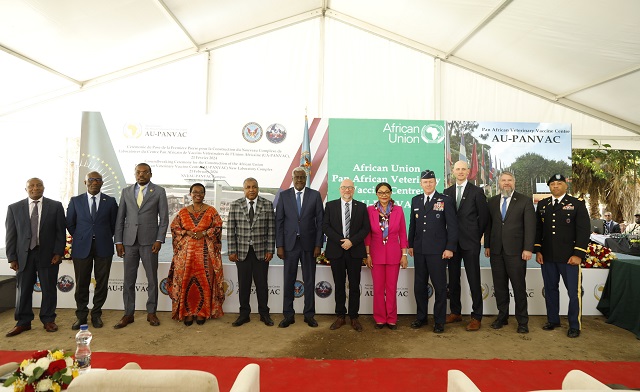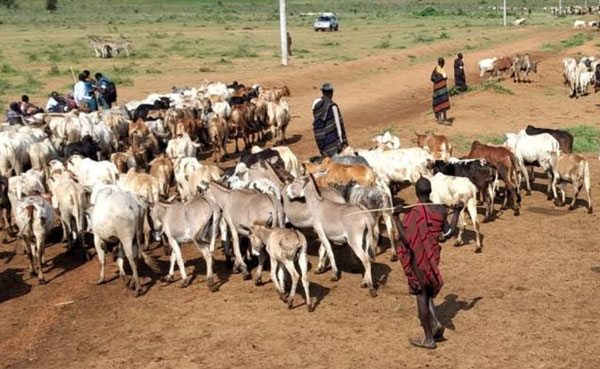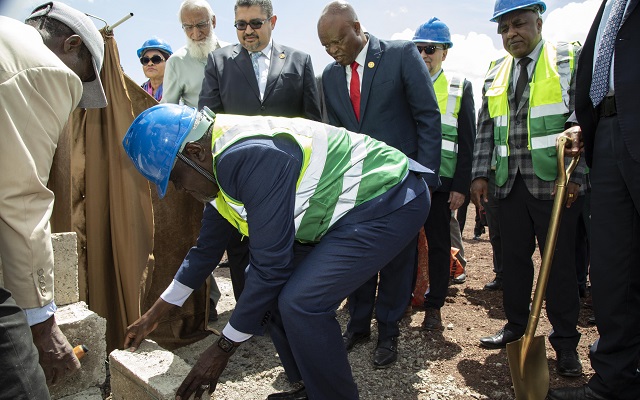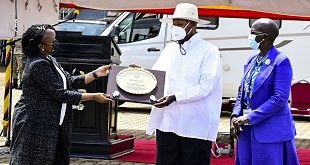
US$ 57 million ultramodern AU-PANVAC laboratory complex to tackle rising livestock disease burden
Bishoftu, Ethiopia | RONALD MUSOKE | The United States government through its Defence Threat Reduction Agency’s (DTRA) biological threat reduction programme (BTRP) has boosted the capacity of the African Union-Pan African Veterinary Vaccine Centre (AU-PANVAC) to respond better to the ever-growing challenge of dangerous livestock diseases that millions of African farmers continue to grapple with.
The AU-PANVAC laboratory which was founded about 20 years ago is a continent-wide veterinary reference laboratory. It also serves as the only Food and Agriculture Organization of the United Nations (FAO) and World Organization for Animal Health (WOAH) approved Rinderpest holding facility in Africa.
Speaking on Feb.21 during the groundbreaking ceremony in the central Ethiopian city of Bishoftu, Dr. Robert Pope, the U.S. Department of Defense Director of the Cooperative Threat Reduction Programme at DTRA said the successful implementation of the laboratory facility will strengthen PANVAC’s ability to control and eradicate animal diseases and develop vaccines for high threat veterinary pathogens.
“The African Union is one of our most esteemed partners on the continent (and) our partnership serves as a standard which DTRA aspires for all our international partnerships,” said Dr. Pope.
“The AU’s continued dedication to PANVAC has been critical to the success we are having today and where we will be in future. I have no doubt that DTRA is stronger for what we are accomplishing with the African Union. Equally, I hope that the African Union has found lasting partnership with DTRA.”
The U.S government’s increased investment in livestock health on the continent comes at a time when several African countries are currently grappling with several animal disease outbreaks including; Foot-and-Mouth Disease, Anthrax, African Swine Fever and Rift Valley Fever which have been wreaking havoc and leaving behind destitution among livestock keepers in Kenya, Malawi, Uganda, Zambia and Zimbabwe.
Good animal health equals food security
Mikael Cleverly, the U.S Charge d’Affaires to the African Union told the high-profile guests during the groundbreaking ceremony that people around the world cannot have food security without animal health.
“So, when we pledged to work together internationally on achieving global food security, I hope this shows that we are serious in not only partnering with the African Union but also in partnering broadly so that we can achieve that goal.”
“What I envision is not only food security but food abundance and I know that we can achieve that with the African Union,” Cleverly said.
“My mandate from our Secretary, (Antony) Blinken, is to deepen our partnership and to expand it. And I hope that this will be a sign that we are putting our money where our mouth is and that we are intent on that.”
“And why are we doing that? We believe in the African Union as an organization, we believe in its potential and we see its great impact already. It is essential to the continent and our goals align completely. We see it succeeding now and we see it succeed in future.”
AU-PANVAC’s continental mandate
The establishment of the AU-PANVAC two decades ago and its institutionalization under the African Union is based on the recognition that an independent and secondary level of quality testing is a pre-requisite for minimizing the risks associated with the use of poor-quality or potentially unsafe vaccines.
In addition, the expansion of its mandate to include the control of all veterinary vaccines and the production of essential diagnostic reagents is founded on the belief that livestock health in Africa can be improved by the use of good quality vaccines and good laboratory and diagnostic support.
The laboratory is therefore mandated to oversee the formation of an internationally independent quality control veterinary vaccines produced in Africa; ensure production and distribution of essential diagnostic reagents for animal disease diagnosis and surveillance; transfer of vaccines production technologies in Africa; ensure standardization of vaccines production and harmonization of the quality control techniques in Africa as well as provide training and technical support services to veterinary laboratories.
Josefa Sacko, the Commissioner for Agriculture, Rural Development, Blue Economy and Sustainable Environment at the African Union Commission told The Independent on the sidelines of the groundbreaking ceremony that livestock production on the continent faces many challenges, including animal diseases that are proving to be a major obstacle to the efficiency and sustainability of the livestock sector in Africa.
She added: “These diseases do not only affect animals, but are also a threat to public health, livelihoods and food security in Africa.” “In the African context, vaccination is the most appropriate choice for the control and eradication of animal diseases. It is, therefore, very important that the vaccines given to animals for disease control must be of very high quality.”
Sacko said Africa has a very big livestock potential with many countries including Ethiopia deriving their livelihoods from livestock. But, just like crops need nurturing, she said, by for instance, looking at fertilizer as a key input, the health of animals also matters.
“If you want better quality livestock, you have to look at things like nutrition but also vaccines,” she said, adding that the African Union Commission is happy that “the AU-PANVAC is doing a good job in terms of controlling what type of vaccines we are giving the livestock.”
“They (AU-PANVAC) don’t produce vaccines but they audit the vaccine production laboratories on the continent. This is very important because the continent needs to invest in research.”

Dr. Girma Amente, the Ethiopian Minister of Agriculture and Natural Resources noted how the Ethiopian government is determined to ensure the success of the continental animal vaccine facility. Besides the Ethiopian government securing a 4-hectare land title for the facility, Dr, Amente said the Ethiopian Agricultural Authority has also put in place “a special arrangement” for the AU-PANVAC to facilitate easy custom clearance of received vaccine reagents and consumables as well as exportation of biological reagents.
“Ethiopian Airlines, which is our pan-African carrier flying to most African countries facilitates the receipt of vaccine and biological samples as well as delivery of diagnostic kits and other biologicals to all AU member states,” he said.
Dr. Amente said Ethiopia is among several African countries which manufacture about 20 million animal vaccines some of which are exported to different African countries. However, the majority of the vaccines are locally procured to vaccinate the country’s huge livestock population which include; more than 17 million cattle, 42 million sheep, 52 million goats and 60 million chickens.
“Prevention and control of animal disease outbreaks through vaccination is a priority where Ethiopia spends hundreds of millions of Birr annually for this purpose,” he said, “Quality-assured vaccines are key tools for the control and eradication of some of these animal and zoonotic diseases.
Dangerous pathogens on the rise
According to the World Health Organization (WHO), up to 75% of new emerging infectious diseases affecting humans are zoonotic diseases (animal origin) that can cause epidemic/outbreaks leading to high rates of morbidity and mortality in humans and animals, disruption of regional and global trade and straining national and global public health resources.
Africa is facing a growing risk of outbreaks caused by zoonotic pathogens. According to a recent analysis done by the WHO, there has been a 63% increase in the number of zoonotic outbreaks in the region in region in the decades from 2012-2022 compared to 2001-2011.
The increase in zoonotic cases may be due to several reasons, the WHO noted in a report published in 2022. For starters, Africa has the world’s fastest growing human population and there is a growing demand for food derived for food derived from animals including meat, poultry, eggs, and milk.
The population growth has also led to rise in urbanization and encroachment on habitats of wildlife. Road, rail, boat and air links are also improving across Africa increasing the risk of zoonotic disease outbreaks spreading from remote areas where there are few people to large urban areas.
“Infections originating in animals and then jumping to humans have been happening for centuries but the risk of mass infections and deaths had been relatively limited in Africa. Poor transport infrastructure acted as a natural barrier,” said Dr. Matshidiso Moeti, the WHO Regional Director for Africa.
“However, with improved transportation in Africa, there is an increased threat of zoonotic pathogens travelling to large urban centres. We must act now to contain zoonotic diseases before they can cause widespread infections and stop Africa from becoming a hotspot for emerging infectious diseases.”
Dr. Pope said when the PANVAC facility is completed in 2028 at a cost of 3.1 billion Birr (US$ 57 million), it will reduce the threat of dangerous animal pathogens on the continent as well as improve the lives of African livestock keepers.
He also noted that the U.S investment in the AU-PANVAC is part of a wider global security vision– the One Health approach. “The One Health approach understands that the health of people is closely connected to the health of animals and our shared environment,” he said, adding that, “Livestock health in Africa can be substantially improved by the use of high-quality vaccines derived from robust laboratory diagnostic standards.”
“Our One Health objective is to ensure PANVAC has the capabilities to realise the African Union’s commitment to prevent the spread of high threat veterinary pathogens. Dr. Pope noted that PANVAC’s implementation of the One Health approach will also improve regional, continental and global biosafety and security demonstrating that multinational partnerships are the foundation upon which global health stands.
New complex a game changer for livestock
Launched in 2004, the AU-PANVAC is currently the only continental agency mandated by the AU to provide internationally independent quality control of all vaccines used in Africa. In addition, it has the mandate to produce and distribute essential biological reagents for the surveillance and diagnosis of animal diseases.
In its 20 years of existence, the AU-PANVAC, which is only one of four global rinderpest holding facilities and the only one to hold both materials and emergency preparedness vaccines, has been credited for playing a major role in the eradication of the rinderpest disease.

It is also been recognized as a World Reference Centre by the World Animal Health Organization (WOAH) and the Food and Agriculture Organization of the United Nations (FAO). It is home to the continental vaccine bank which was established in 2018 to ensure emergency preparedness and response to any possible outbreaks of Rinderpest and other animal diseases in Africa.
The AU-PANVAC tests more than 400 vaccine batches annually representing over one billion vaccine doses and it also develops diagnostic tests to support the continental eradication of peste des petits ruminants (PPR) which reduced the cost of testing small ruminants sera by 75%.
It also provides regular training to African Union member states (more than 2000 laboratory scientists trained) and transfer of new vaccine production technologies. It is certified in quality management system and accredited for laboratory management system by international vaccine manufacturers networks.
However, in doing all this work, the PANVAC has been operating from laboratories donated by the Ethiopian Government’s National Veterinary Institute facility in Bishoftu, in central Ethiopia.
For many years, officials at the PANVAC say, the existing facilities have not been able to allow the continental facility fulfil its mandate adequately due to a steady increase in demand for services from AU member states such as the quality control of vaccine batches, technical support, training and the number of diagnostic kits to be produced. It is hoped that the new complex will now enhance the capacity of the centre to support the control of animal diseases according to international standards and best practices.
Dr. Charles Bodjo, the Acting Director of the AU-PANVAC told The Independent on the sidelines of the groundbreaking ceremony that he hopes the facility will boost the transfer of vaccine production technology among member states of the African Union. “We should be able to produce more high-quality vaccines.”
Moussa Faki Mahamat, the Chairperson of the African Union Commission said the laying of the foundation stone for the construction of the new laboratory complex of the AU-PANVAC with the support of the U.S Defence Threat Reduction Agency is an expression of the shared commitment by the African Union and the U.S government to addressing common challenges in controlling animal diseases for sustainable livestock production, food security and nutrition and poverty reduction in Africa and beyond.
Faki also thanked the U.S government’s substantial support of the AU-PANVAC over the years through DTRA for capacity building in biosecurity and biosafety, and the architectural design of the new laboratory complex.
“This partnership between the AU and the U.S government represents an innovative and transformative collaboration that can yield significant benefits across various fields,” he said.
“I am convinced that the ultra-modern architecture of PANVAC’s future laboratory complex will enable it to strengthen its position as a centre of excellence for research, development, and technology transfer for the production of veterinary vaccines in Africa to protect the livestock on which so many of our communities depend.”
He added: “Our vision goes beyond the walls of the laboratory. The AU-PANVAC will serve as a platform for collaboration, bringing together experts, researchers and policymakers from across the continent.”
“By sharing knowledge and expertise, we aim to address the unique veterinary challenges faced by different regions, promoting a Pan-African approach to disease prevention and control to achieve our Agenda 2063 for the “Africa we want.”
 The Independent Uganda: You get the Truth we Pay the Price
The Independent Uganda: You get the Truth we Pay the Price


